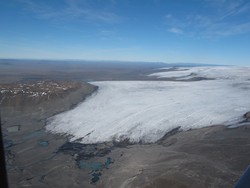Ice cave in Hofsjökull – a warning
Ice caves are often found at glacier edges in Iceland, formed either by meltwater flow beneath the ice or by geothermal activity (such as the well-known ice caves in Kverkfjöll).
News has recently been shared about a newly discovered ice cave in Blágnípujökull, a SW outlet from the Hofsjökull ice cap in central Iceland, where a child has collapsed due to breathing in toxic gases. Fifteen years ago, geothermal activity which melted a hole in the ice cover, accompanied by a strong sulfur smell, was observed at this same location.
The cave was visited on February 3. The atmospheric concentrations of oxygen (O2), carbon monoxide (CO), hydrogen sulfide (H2S) and sulfur dioxide (SO2) were measured with a handheld sensor inside the 150 m long cave. The visitors smelled sulfur outside the entrance and inside the cave. H2S concentrations of up to 60 ppm were measured inside the cave. Exposure to concentrations of H2S this high are potentially harmful, and exposure to 60 ppm for 1 hour can cause severe breathing problems and damage to the eyes. The measurements were for only one visit. It is possible that higher concentrations of gases may accumulate in the cave. It is unknown what concentration of gas the above mentioned child was exposed to.
The cave should not be entered without gas monitoring instruments that can give warnings of dangerously high concentrations of H2S. We urge people to avoid such high concentrations of H2S as only goggles and a gas-mask can provide adequate, short-term protection. At 20 ppm of H2S some people will stop smelling the gas and at 100 ppm of H2S there are significant threats to life and health.
In addition to poisonous gases, loose chunks of ice hanging from the roof of the ice cave and a very slippery floor can present serious dangers. A small jökulhlaup (glacier outburst flood) seems to have emerged from beneath the glacier at this location, breaking up the ice and transporting large chunks of glacier ice several hundred meters downstream. Future outburst floods could presents an additional, unmonitored hazard.
Note that Hofsjökull is located in an inaccessible part of the highlands and no roads or tracks lead to the Blágnípujökull outlet glacier.
A report in Icelandic on dangers in ice caves can be downloaded here.




